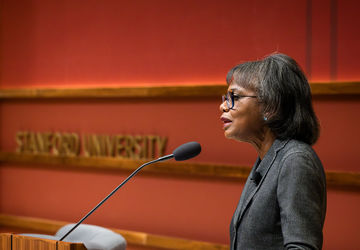A new look at German medieval history: Nontraditional artifacts reveal central roles of women

What can a set of 1,000-year-old teeth tell us about gender and labor? Quite a lot, as it turns out. At a recent Faculty Research Fellows talk at the Clayman Institute, Stanford Professor of German Studies Kathryn Starkey explained how, using a range of unconventional sources, she and Professor of History Fiona Griffiths are offering a new narrative of German medieval history. Their current book project, A History of Medieval Germany (900-1220), part of the Cambridge Medieval Textbook series, reimagines this period. Instead of focusing on kingly or religious power, as do traditional textbooks, Starkey and Griffiths place women at the center of their story. In so doing, they reveal the importance of women as artisans, cultural ambassadors, and rulers.
The project presents significant challenges. Few texts penned by women from this period still exist. This means that Starkey and Griffiths must look beyond traditional sources such as charters or treatises to other kinds of materials that have survived into the modern era. In her presentation, Starkey used four such examples—the aforementioned teeth, a Psalter, the medieval legend of Gregorius, and a lead burial plaque—to explain women’s centrality to certain kinds of skilled labor, their importance as cultural ambassadors, and the multifaceted familial and political roles they inhabited.
The remarkable travels of this manuscript in the 11th and 12th centuries … attest to women’s importance as cultural ambassadors.
Take the teeth, for instance. Discovered in 2019 by archaeologists in Dalheim, Germany, the teeth, which had belonged to a woman, upended long-held understandings about production of the illuminated manuscripts that were so important during the medieval period. Previously, scholars assumed that women had played only a minor role in their production. These human remains led to an astonishing insight. A residue found on the teeth turned out to be lapis lazuli, a precious stone sourced from what is now Afghanistan. Prized for its brilliant blue color, the gem was ground into a powder and used to illuminate manuscripts. The residue revealed that the woman had almost certainly worked as a scribe, dipping the brush in her mouth to shape the bristles as she painted. Not only did the evidence show the involvement of women in the use of costly materials, but also points to their involvement in long-distance trade. As Starkey explained, the teeth “open up the possibility of studying a life that had previously been unknown and for which we have no other documentation.”
Or, to take another of Starkey’s examples, consider the Egbert Psalter. A richly illustrated religious manuscript, it was passed down across several generations of noblewomen, who carried it with them as they journeyed great distances to marry. Over the course of 100 years, the book circulated among far-flung cities, including Reichenau, Krakow, and Kiev, before finally returning back to Germany. “The remarkable travels of this manuscript in the 11th and 12th centuries … attest to women’s importance as cultural ambassadors,” Starkey argued. She described clues contained within the psalter itself that give evidence of women’s literacy and education. For example, one owner of the psalter added her own personal prayers and illustrations. Elite women would have needed cultural flexibility and linguistic fluency as they moved across political boundaries to marry and cement alliances. As Starkey observed, medieval German history looks completely different when narrated through the lens of marriage alliances.
Starkey’s careful consideration of non-traditional sources allows the full complexity of medieval German women’s lives to come into focus. Her fine-grained analyses reveal the gendered possibilities and limitations of this period.


